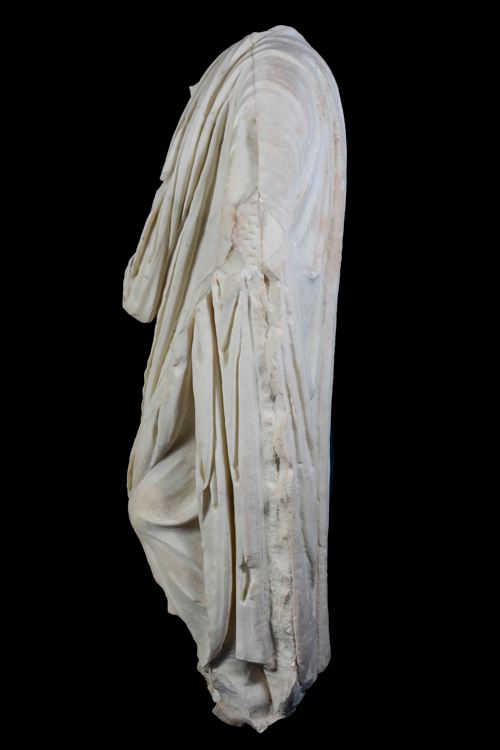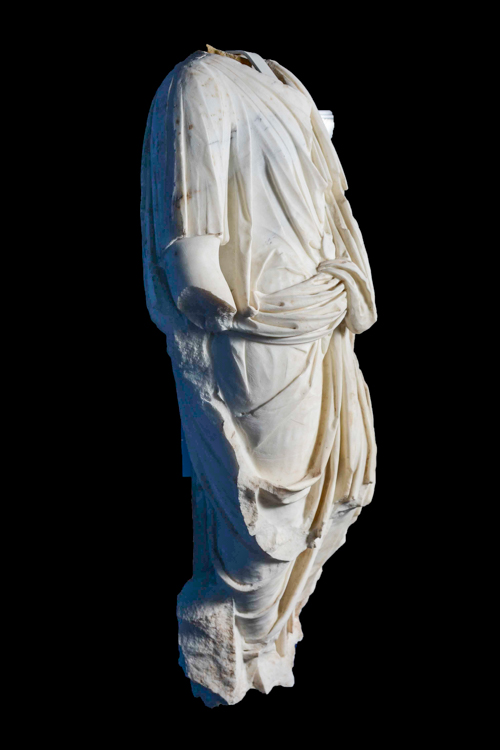Statue of a boy in toga
Category
Domus Romana GroupAbout This Artefact
I.D. no: 15887
Dimensions: Max. H. 114 cm; Max. W. 53 cm
Material: Very fine grain white marble with some grey veins (most obvious on the right upper torso) and a honey-coloured patina.[1]
Provenance: The 1881 excavations of the Roman Domus in Rabat, Malta
Current location: Domvs Romana Museum in Rabat, Malta.
Condition: Totally missing are the separately worked head and both forearms. Major breakages: the largest one around the left elbow where two iron dowels must have secured the separately attached left forearm; the break affects also the drapery of the upper arm and some of the thicker folds below the arm. Two largish breaks almost eliminate the small scrinium by the right foot, sparing part of a flat ribbon visible on the surviving original cylindrical surface. A few medium-sized breaks along the folds of the toga sinus. Most of the parts of the flat base (c. 3 cm thick) that projected beyond the figure are missing, especially at the back. The fore sections of the feet are also missing. Smaller chippings affect the more vulnerable edges of the drapery folds.
A noticeable defect of the marble block is a fault line running down the whole left shoulder to the middle of the upper left arm, which must have determined the neat cut of one side of the major break provoked by the iron dowels. Below the latter, the whole length of the projecting thick fold of drapery is affected by breakages down to the left foot. The broken right forearm was not attached by a dowel; behind it is another broken fold.
Description: The figure, which is clad in toga over a short-sleeved tunic, stands with its weight supported on the right leg, the left leg being bent forward and relaxed, raising the left foot slightly off the ground. The folds of the drapery are broad, deeply undercut and life-like. The right hand was probably extended forward and held forth an object, probably a scroll. The left hand seems to have been raised to the height of the elbow. The feet are shod in the patrician calcei.[2] A pair of thongs is knotted over the instep of each foot.
The bulla hanging over the chest above the umbo indicates that the torso represented a young boy and the statue was therefore life-size. A scrinium, intended to contain papyri scrolls, serves as a further support to the right and back of the statue.
The drapery of the toga, which leaves bare the tunic over the right shoulder and chest, flows with a festive exuberance, enriched by the plasticity of the folds and underscored by deep shadows. The strongly bent left leg gives a sense of movement hardly ever encountered in similar togate statues of the early Julio-Claudian period, which tend to be more static. It permits greater mobility in the arrangement of the folds of the toga and a more organic integration of dress and body. Wherever the cloth hangs freely, it is rich in folds and contrasts with the parts that adhere to the limbs. The chiaroscuro effect is accentuated in the lower part of the statue whereas its upper part, particularly in the area around the right shoulder the treatment is rather conventional.
The general treatment of the folds at the backside is shallow but the projecting vertical folds on the right side contrast with the herring-bone design of the shallower ones on the left side. Two faint horizontal grooved lines on the right thigh constitute a rather unusual and intriguing detail.
Discussion: Similar togate statues of young boys wearing the characteristic bulla can be cited from Veleia, now in Parma,[3] from Tarragona,[4] in the Vatican Museum,[5] and in the Louvre.[6] The Rabat statue seems to have surpassed the quiet and sober dignity of the Augustan and Tiberian togate statuary and to be well on its way towards assuming the full pictorial flair of Flavian plasticism. A date in the late Claudian reign seems to be further corroborated by comparison with other statues of that period, such as the statues from Veleia and in the Louvre already cited,[7] as well as the more exuberant portrait statue of Emperor Titus.[8] The toga in the Maltese statue appears more voluminous, richer and permeated by a greater sensitivity for minute details. All this contributes to make this marble one of the best works of Roman statuary of this period. H. R. Goette classifies it under his Type Ba, namely, toga with U-shaped umbo, and dates it to the mid-first century AD.[9]
The presence of the bulla hanging from the boy’s neck indicates that the boy has still not assumed the toga virilis, a rite of passage from boyhood to manhood which normally took place at the age of fourteen to seventeen.[10] The size of the torso suggests an age around thirteen. This would fit perfectly the age of Nero, the future emperor, between AD 50, when he was formally adopted by Claudius, and AD 51, when he assumed the toga virilis. In AD 53, still within the reign of Claudius, Nero married Claudia Octavia, Claudius’ daughter by Messalina, thus reaffirming his position as heir apparent by becoming also Claudius’ son-in-law. That event, however, places his identification in the Rabat headless statue earlier than this date.
Given the context of its discovery, in the company of the portraits of Claudius and, probably, Claudia Antonia (his daughter) and Agrippina Minor (his fourth and last wife), the identification with the young Nero, at the age of thirteen, the year before his adoption by Claudius and before his admission into adulthood in AD 51,[11] leaves very little room for doubt.
Bibliography: (previous publications of item): Caruana 1881: 7, pl. without number at end of booklet: Ashby 1915: 40, fig. 11: “Statue of a boy in a toga, in Luna (?) marble (no. 30, fig. 11) 3 feet 8 inches high”. Reinach 1924: 357, 3. Zammit 1930: 22 and pl. without number: repeats Ashby. Bonanno 1971: 174-78. Goette 1990: 123-24, no 213 (c. mid-first century AD). Bonanno 1992: 23, note 64, pl. 25 (young Nero). Bonanno 1997. Bonanno 2005: 222-24.
[1] Identified as “Luna (?) marble” by Ashby (1915: 40), the same by Susan Walker on 14/10/1989; as Pentelic by L. Lazzarini (personal communication 24.02.04).
[2] Even though the upper straps are not clearly visible. For the calcei patricii see Goette 1988, especially fig. 35.
[3] Saletti 1968: 49-52, no 11, pls 35-36.
[4] García y Bellido 1949: 189-90, no 219, pl. 159
[5] Goethert 1939: 193-94, pl. 43,2.
[6] Goethert 1939: 206, pl. 48,2. For another good comparandum see Aphrodisias Papers 2: 95 and note 43, where the “young togatus” is compared to the young Nero in the Louvre.
[7] Saletti (1968: 49-52, no 11) correctly assigns the young Nero from Veleia to the advanced Claudian period on the basis of a comparison with the Louvre Nero, erroneously classified as Flavian by Goethert (1939: 206, pl. 48. 2). The correct (i.e. late-Claudian) date of the latter is given by Niemeyer (1968: 84, no 11, pl. 3,2).
[8] Amelung 1903: 40-41, no 26, pl. 4; Niemeyer 1968: 84, no 12, pl. 5,1.
[9] Goette 1990: 123-24.
[10] For the bulla see Goette 1986; 1990: 104.
[11] By March of 51 Nero was invested with the Imperium Proconsulare Extra Urbem and, consequently, he must have relinquished the bulla by then.




